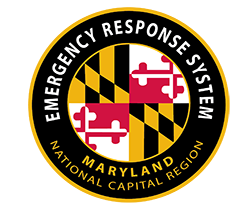The Maryland-National Capital Region Emergency Response System (MDERS) is proud to announce the continued expansion of its Public Access Trauma Care (PATC) program through the publication of the Maryland Public Access Trauma Care mobile application. This application builds upon the deployment of trauma kits, resources, and training opportunities throughout the region by providing a supplemental, on-demand educational resource to citizen responders.
The Maryland Public Access Trauma Care application is organized into three sections: In an Emergency, PATC Training, and Resources. Each section consists of a variety of interactive tools, references, and videos to provide users with the knowledge, skills and abilities required to save an individual suffering from life-threatening trauma. These sections are further detailed below.
 In an Emergency
In an Emergency
The In an Emergency section of the application outlines easily navigable, step-by-step instructions for users to follow when confronted with a bleeding victim. This section is further organized into three subsections: Initial Actions, Injury Patterns, and After Applying Aid. Through these subsections, the application outlines primary actions that a citizen responder should take when responding to any victim, high-level medical instructions for responding to four major injury patterns, and a list of actions to be taken after delivering immediate medical aid.
Each medical procedure contains a link to the corresponding training video to ensure that user can quickly review, listen to, and/or visualize the appropriate actions to be taken.
 PATC Training
PATC Training
The PATC Training section of the application educates individuals on the various medical procedures that may be involved when responding to a major bleeding injury. These trainings encompass numerous aspects of responding to a medical emergency including assessing the scene for safety risks, alerting 9-1-1, identification of common injury patterns and locations, application of appropriate medical procedures, common medical equipment used to treat bleeding victims, and more.
 Resources
Resources
The Resources section provides users the ability to expand upon, strengthen, and evaluate their mastery of the concepts taught in the PATC Training section of the app. This section includes detailed training videos for identified medical procedures, an interactive quiz to test the user’s knowledge, a map of National Capital Region hospital locations, and information on creating a trauma kit. Additionally, users can identify ongoing training opportunities or even request an in-person training event.
The Maryland Public Access Trauma Care app can be downloaded in the Apple App Store and Google Play Store today.










 The videos show the proper techniques and tools to treat life-threatening injuries using the equipment and supplies provided in the PATC kits. Students learn how to accurately identify the type and extent of an injury, how to render aid, and which bandages and supplies to use. The five training videos teach individuals how to apply a chest seal, apply a tourniquet, pack a wound, apply direct pressure, and maneuver a victim into the recovery position. Each video demonstrates the application of a skill with detailed narration explaining each step taken by a citizen responder.
The videos show the proper techniques and tools to treat life-threatening injuries using the equipment and supplies provided in the PATC kits. Students learn how to accurately identify the type and extent of an injury, how to render aid, and which bandages and supplies to use. The five training videos teach individuals how to apply a chest seal, apply a tourniquet, pack a wound, apply direct pressure, and maneuver a victim into the recovery position. Each video demonstrates the application of a skill with detailed narration explaining each step taken by a citizen responder.
 The MDERS Tabletop in a Box program is a coordinated effort with stakeholder agencies to provide a portable Incident Command System (ICS) training tool. The Tabletop in a Box program includes pre-scripted exercises, manipulatives, and maps of target hazard locations within their area of jurisdiction. This programs main tool is a portable box containing all materials required to run a hybrid exercise. This approach provides stakeholders with a forum to discuss, evaluate, and deconflict their response policies and procedures in a collaborative environment.
The MDERS Tabletop in a Box program is a coordinated effort with stakeholder agencies to provide a portable Incident Command System (ICS) training tool. The Tabletop in a Box program includes pre-scripted exercises, manipulatives, and maps of target hazard locations within their area of jurisdiction. This programs main tool is a portable box containing all materials required to run a hybrid exercise. This approach provides stakeholders with a forum to discuss, evaluate, and deconflict their response policies and procedures in a collaborative environment.







